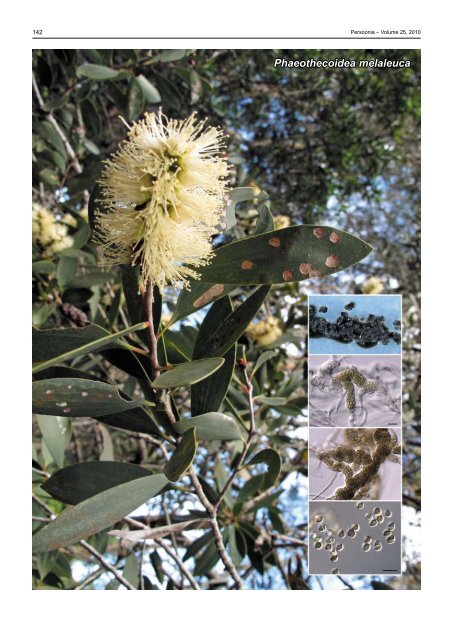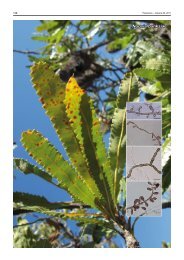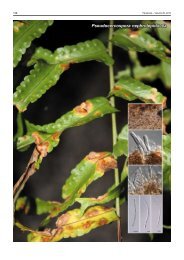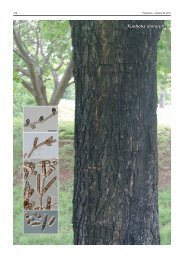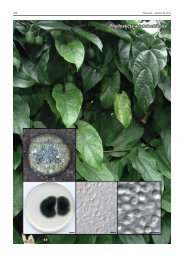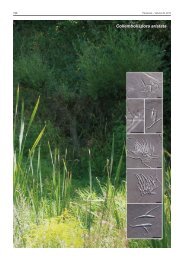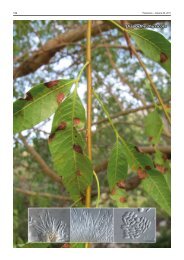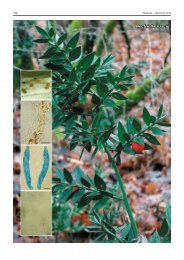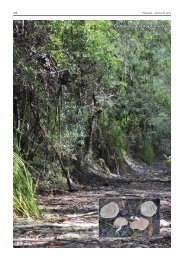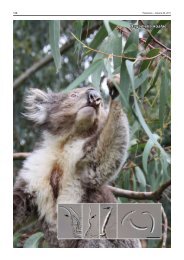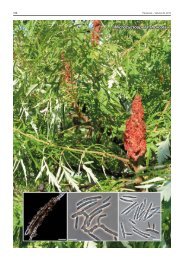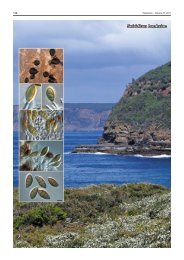Phaeothecoidea melaleuca - Fungal Planet
Phaeothecoidea melaleuca - Fungal Planet
Phaeothecoidea melaleuca - Fungal Planet
Create successful ePaper yourself
Turn your PDF publications into a flip-book with our unique Google optimized e-Paper software.
142 Persoonia – Volume 25, 2010<br />
<strong>Phaeothecoidea</strong> <strong>melaleuca</strong>
Persoonial Reflections<br />
143<br />
<strong>Fungal</strong> <strong>Planet</strong> 61 – 23 December 2010<br />
<strong>Phaeothecoidea</strong> <strong>melaleuca</strong> Crous & R.G. Shivas, sp. nov.<br />
<strong>Phaeothecoidea</strong>e proteae similis, sed conidiis minoribus, (5–)6–7(–8) ×<br />
(4–)5–6 µm, distinguitur.<br />
Etymology. Named after the host genus from which it was collected,<br />
Melaleuca.<br />
Mycelium consisting of branched, septate, pale to medium<br />
brown, 3–5 µm diam hyphae, frequently constricted at septa<br />
and encased in a mucoid sheath which results in black, shiny<br />
exudate on the surface of agar media; hyphal ends becoming<br />
swollen, ellipsoid, 20–35 µm wide, 25–70 µm long, filled with<br />
endoconidia. Endoconidia brown, thick-walled, smooth to finely<br />
verruculose, ellipsoid to globose, 0–1-septate, (5–)6–7(–8) ×<br />
(4–)5–6 µm.<br />
Culture characteristics — (in the dark, 25 °C, after 2 wk):<br />
Colonies spreading, flat, folded, with sparse aerial mycelium,<br />
and smooth, lobate margins, exuding copious amounts of black<br />
slime; reaching 15 mm diam. On oatmeal agar, potato-dextrose<br />
agar and malt extract agar, olivaceous-black.<br />
Typus. Australia, Queensland, Brisbane, Slaughter Falls, 27°28'35"S<br />
152°57'48.9"E, on leaves of Melaleuca quinquenervia, 16 July 2009, P.W.<br />
Crous & R.G. Shivas, CBS-H 20494 holotype, cultures ex-type CPC 17223,<br />
17224 = CBS 128213, ITS sequence of CPC 17223 GenBank HQ599594 and<br />
LSU sequence of CPC 17223 GenBank HQ599595, MycoBank MB517541.<br />
Notes — A megablast search in GenBank using the LSU<br />
sequence retrieved as closest sister species Readeriella brunneotingens<br />
(GenBank EU019286; Identities = 887/907 (98 %),<br />
Gaps = 7/907 (0 %)), Teratosphaeria dimorpha (GenBank<br />
FJ493215; Identities = 886/907 (98 %), Gaps = 7/907 (0 %))<br />
and Penidiella columbiana (GenBank EU019274; Identities =<br />
885/906 (98 %), Gaps = 5/906 (0 %)). A megablast with the ITS<br />
sequence revealed as closest sister species <strong>Phaeothecoidea</strong><br />
proteae (GenBank EU707898; Identities = 604/646 (94 %),<br />
Gaps = 20/646 (3 %)) and Batcheloromyces leucadendri (Gen-<br />
Bank EU707890; Identities = 593/642 (93 %), Gaps = 20/642<br />
(3 %)). Morphologically P. <strong>melaleuca</strong> and P. proteae are distinct,<br />
in that endoconidia of P. proteae are verruculose and larger in<br />
size, (6–)8–10(–13) × (4–)5–6(–11) μm than those of P. <strong>melaleuca</strong><br />
1 .<br />
Colour illustrations. Melaleuca quinquenervia; colony on potato-dextrose<br />
agar; hyphae with endoconidia; endoconidia. Scale bars = 10 µm.<br />
Reference. 1 Crous PW, Summerell BA, Mostert L, Groenewald JZ. 2008.<br />
Host specificity and speciation of Mycosphaerella and Teratosphaeria species<br />
associated with leaf spots of Proteaceae. Persoonia 20: 59–86.<br />
Pedro W. Crous & Johannes Z. Groenewald, CBS-KNAW <strong>Fungal</strong> Biodiversity Centre, P.O. Box 85167, 3508 AD Utrecht, The Netherlands;<br />
e-mail: p.crous@cbs.knaw.nl & e.groenewald@cbs.knaw.nl<br />
Roger G. Shivas, Agri-Science Queensland, Ecosciences Precinct, Dutton Park 4102, Queensland, Australia;<br />
e-mail: roger.shivas@deedi.qld.gov.au<br />
© 2010 Nationaal Herbarium Nederland & Centraalbureau voor Schimmelcultures


